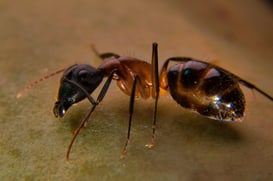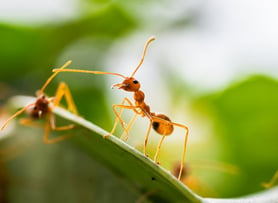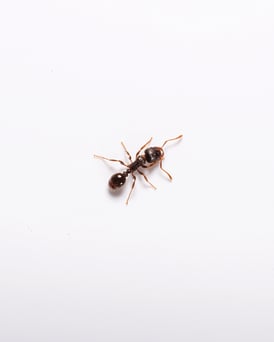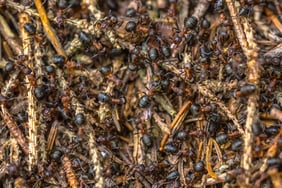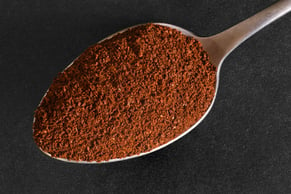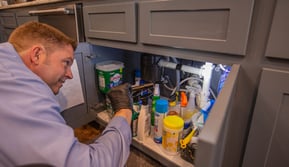Sugar Ants: Why You Have Them & How to Get Rid of Them
We’ve all been there. You’re making your morning brew, breathing in the sweet aroma of freshly made coffee, when you reach for your sugar bowl and realize it’s… moving. Little ants are scurrying on the counter, on the sugar spoon, even in the sugar itself! On closer inspection, you begin to notice ants have made camp in several different corners of the kitchen. It feels like the whole room is suddenly crawling with tiny, unwelcome visitors.
We’ve all been there. You’re making your morning brew, breathing in the sweet aroma of freshly made coffee, when you reach for your sugar bowl and realize it’s… moving. Little ants are scurrying on the counter, on the sugar spoon, and even in the sugar itself! On closer inspection, you begin to notice ants have set up camp in several different corners of the kitchen. It feels like the whole room is suddenly crawling with tiny, unwelcome visitors.
How did this happen?!
What are sugar ants and how do I identify them?
“Sugar ant” is the universally adopted term for homeowners who experience ants in their homes. The real sugar ant actually resides in Australia and probably isn’t the true culprit for creepy-crawlies in your American kitchen. Instead, you may be experiencing the infiltration of a number of different ants, most of which seem to be attracted to sugary foods. Many of these ants look very similar in size, color, and shape, making identifying them surprisingly difficult for the average person. With over 10,000 varieties of ant, it’s no wonder homeowners have opted for a catch-all term that best describes their problem pest!
There are a few common ants that many homeowners will encounter at some point in their lives. This includes odorous house ants, minuscule black or brown ants that are attracted to moisture. Odorous house ants, as their name suggests, emit a unique, rotten coconut-like (some say sweet!) smell when they are stepped on or squished. Though they don’t directly pose a health risk to homeowners, they can quickly contaminate food supplies and also happen to be the #1 ant problem in the Northeast. They are also the ant most commonly dubbed a "sugar ant" by homeowners due to their similar characteristics, despite being smaller and uniquely aromatic.
Another frequently found ant includes the pharaoh ant, which is best known for its inconspicuous small size and resistance to removal efforts. Yellow in color, these ants are attracted to food, sweets, and even other dead insects. Unlike the odorous house ant, pharaoh ants can easily spread disease and cause significant health issues to humans.
Still, there are pavement ants, who generally prefer to live outside near sidewalks, but occasionally wander inside in search of food. Pavement ants are typically larger, brown or black insects and are regarded as a difficult population to control, especially when mating. In addition, pavement ants have been known to sting when they perceive a threat.
Because most ants tend to look similar, it often requires a pest control professional to properly identify the ant and therefore effectively treat an ant problem. Consider contacting a reputable pest control service like EcoShield for help in identifying and eradicating ants.
Why do I have sugar ants all over my kitchen?
If you’re having an ant problem in your kitchen, it’s important to know what attracts them. Sugar ants are first and foremost interested in sweet and sugary foods that are typically kept in kitchens. They often convene around unnoticed spills, sticky countertops, or dropped treats on the floor. Sugar ants will also sneak into closed cabinets or cupboards in search of hidden-away sweets, searching for any small cracks and crevices to enter through. This is why even the most vigilantly cleaned kitchens can still encounter ant infestations, despite taking proper precautions such as:
- Monitoring and cleaning pet food bowls
- Making sure there are no crumbs under the kitchen table
- Cleaning up spilled food or drinks
- Keeping lids on trash cans
- Making sure over ripe fruit is not left out on the counter
- Not leaving dirty plates stacked in the sink or left out on the counter
- Properly sealing sealed containers of food in your cabinets and pantry
- Not having dripping faucets or leaky sink pipes
- Keeping garbage cans clean from leftover residue
- Checking to ensure there are no cracks or little openings around the foundation of your home
It can be especially difficult for homeowners with children or pets to keep ants at bay. Frequent spills or small messes act as beacons to sugar ants. While routine cleaning attempts can sometimes be effective, it should be understood that ants can be an incredibly challenging pest to rid yourself of completely. They are remarkably resilient and can make themselves at home virtually anywhere.
Prevention is usually much easier and more manageable than attempting to treat an infestation. If you’ve experienced ant problems in the past or are concerned that your home may be at risk, contact EcoShield for an inspection and front-line treatment plan. Protecting yourself prior to ants becoming a problem is the single best way to avoid ants altogether. Our year-round Shield Protection Plan can also prevent and control ants before they become a problem.
Okay – I have sugar ants. (Like, a lot of them.) Now how do I get rid of them?
Having your living space taken over by tiny intruders can be extremely overwhelming for any homeowner. You’ve tried to take the proper precautions and even did some research, but you’re feeling more lost than ever. How do I get rid of them? How do I know what kind of ant is in my kitchen? Who do I contact? Can I handle this myself? Are ant pest control solutions effective? Are they safe? Am I going to have to sign over my home’s deed to these ants?!
The good news is you CAN get rid of even the most persistent and headache-inducing ant problem. In fact, you even have a few options regarding how to do it. When determining the best ant solution for you, remember that different treatments have varying degrees of effectiveness. It is also paramount that you ensure whatever treatment you choose is safe for you and any children or pets within your home. Keep in mind that while DIY solutions often seem to be more cost-efficient, they can quickly add up if you need to cycle through several different products due to unsuccessful attempts. Many of these products can also push the ants to another location in your home and potentially make the problem worse (and more expensive to fix!)
I've tried DIY solutions but the ants keep coming back!
While you may want to try DIY solutions before calling in a professional, it’s important to understand the nature of an ant infestation. The life of a worker ant revolves solely around protecting the colony and finding food. These are the ants that you’re likely to spot on your countertops or climbing up the wall in your kitchen – but they only represent a small percentage of the total colony.
Spot-treatments, sprays, and baits can be effective at stopping the ant activity you see in your home, but the nest with the rest of the colony may be out of sight. To completely stop ants from making a reappearance, you have to reach the source of the infestation. This is where many DIY solutions fall short.
Ants can be challenging to remove if you aren’t targeting the source. Without targeting the nest, you’ll only be killing the ants that you can visibly see. Ant colonies mostly exist outdoors, not indoors. and the ants you are seeing are actively going after food and water to bring back to the colony. By making your home less desirable to ants, the colony is less likely to invade.
Not only are ants difficult to eliminate, but they are very abundant. Colonies of odorous house ants can grow into the thousands and occur throughout your property. When they’re not in your home, odorous house ants live in the soil under rocks, in potted plants, and within piles of wood. To make it even more complicated, their nests move from place to place, making it extremely difficult to fully eradicate the problem without professional pest control.
Some common DIY ant treatments include:
Food Barrier Method: This method hinges on locating the entry point for your ants, sealing it, and using some version of a food item to act as a barrier in areas ants gather. The idea is that ants enter your home through the outside, so by identifying this point of entry and sealing it off, they won’t be able to enter anymore. This is often easier said than done, as locating entry points can be challenging, and it is difficult to know if you've found every entrance. Additionally, it's recommended you clean where the ant’s trails were as they tend to follow the same path methodically. It's believed that scrubbing the paths away with confuse future ants attempting to follow a familiar trail.
The last step of this method is to create a barrier to use at this entry point and wherever ants would gather. Some food items homeowners have tried to prevent ants from crossing include coffee grounds, black pepper, citrus, bay leaves, cucumber peels, ground cinnamon, or cayenne pepper. Some individuals have also reported success with pungent essential oils.
It is uncertain how effective this method is, but it has some anecdotal evidence of success for some homeowners.
White Vinegar Method: This simple and natural sugar ant solution method involves mixing 50/50 white vinegar and water in a spray bottle. The solution will not only kill ants when sprayed directly onto the ants, but it's said it can also act as a deterrent and repel future intrusive pests. The 50/50 solution is not considered a permanent fix for ant problems. It's important to note that while the vinegar will kill the ants on contact, you'll only have treated part of the problem. The couple of ants you spray come from a much larger colony that, when left untreated, will certainly result in more and more ants appearing in your home. Beyond all the frustration of spray, kill, and repeat attempts, you'll also have to deal with the pungent smell of vinegar in your home for an extended period of time -- yuck!
Before spraying vinegar in your home, please research the benefits and potential concerns this method may entail.
Boric Acid and Sugar Trap Method: The boric acid and sugar trap method can be effective in killing ants as long as you get the correct concentration and an attractive sugary sweet. The goal is for ants to eat the baited food, where the ingested boric acid will then act as poison and slowly kill the ant. The key parts in making this method successful are ensuring the correct concentration of boric acid to effectively kill the ant and choosing a food that will be enticing enough to convince all your ants to eat it. It should be noted that this method may not be considered safe for children and pets, and it is recommended you never leave acids unattended.
It should also be noted that this method is not for the impatient. It may take a few months of repeated use to satisfactorily rid yourself of an ant infestation. Much like the white vinegar method, the boric acid and sugar trap solution only treats a small part of the total ant colony. Ants from the colony will continue to venture into your spaces in search of food, meaning this method is far from a permanent solution.
Again, it is not recommended you use this method if you share your home with children or pets. Bait traps should always be well out of reach and boric acid should also be stored securely. Households with sensitive populations affected by an ant infestation are best treated by professional pest control, such as EcoShield Pest Solutions.
Store-bought Sugar Ant Solutions: Do Your Research
There is a multitude of off-the-shelf sugar ant solutions on the market today. Many can be very effective in ridding yourself of sugar ants, while others don’t offer the same success. Choosing the correct store-bought sugar ant solution for you requires a great deal of research and potentially several rounds of trial and error. Please also note that while these solutions may get rid of an ant problem in your home, the ants frequently return as store-bought ant control is often intended to be a "quick fix." If you opt for a retail solution, do thorough research to determine the product’s success, safety, and longevity. Check with the FDA to ensure the product you choose meets all reasonable standards.
How does EcoShield get rid of ants in my home?
The only way to ensure you banish ants for good is to utilize a reputable pest control service like EcoShield Pest Solutions. EcoShield’s botanical solutions are safe and effective in removing any kind of ant that sets up camp in your home. Our 100% guaranteed service will save you the stress of DIY solutions and recurring ant problems associated with them. EcoShield's proactive approach to ant control not only treats the primary pest issue, but also focuses on prevention to ensure there won't be any creepy crawlies in your future.
Call us today for a free no-obligation estimate and take back your kitchen! Call us at: (888) 744-1284 or fill out the form on this page.

